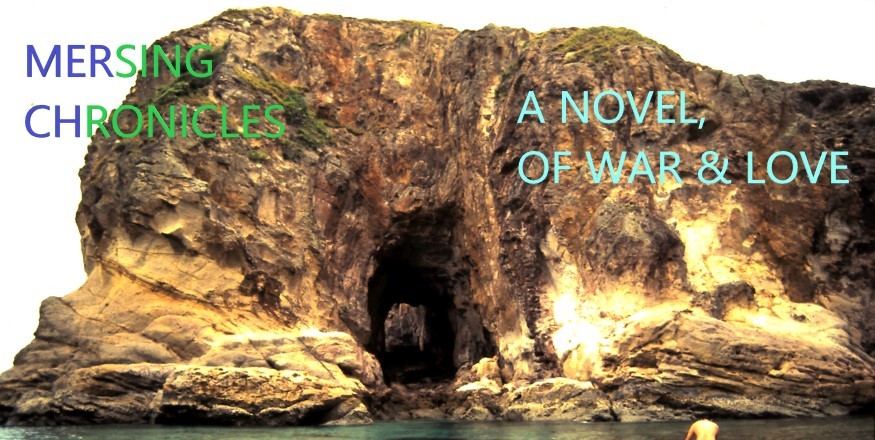30 years ago: Paku Point
"Imagine this," Ken said as they ate breakfast around the kitchen table, "what if the Chinese created a huge underground cavern somewhere where they could build these huge submarine air-craft carriers away from satellites, test them in that cavern and then reveal them to the world at the next conflict."
"It would have to be a humongous cavern," John quipped.
"Large enough to do all the necessary maneuvers an air-craft carrier would need to do," Ken said.
"Sounds far out," Hiang said. "What dimensions would that cavern be?"
"Maybe 3 km long by 2 km wide with a height of at least 1000 foot?" Ken suggested.
"What do you think Nur?" John asked.
"Maybe possible," Nur said.
"You can't divulge classified info even if I hit it on the nail, isn't that right Major?" Ken smiled.
"Exactly."
Later when on Paku Point in the fresh air with only Nur and Hiang lying prone, Hiang asked, "Was Ken right?"
"Sounds like a theory, a plausible theory."
"Didn't Sir Arthur Conan Doyle said when all other possibilities are exhausted, the only remaining possibility is the logical conclusion?"
"An underground cavern of that size would be a huge engineering achievement almost as challenging as going to Mars."
"Why, what are the challenges?"
"Structurally you have to identify the kind of geological feature that could support that cavern. A cavern that is 2 km wide by 3 km long and a 1000 foot high would have to have a geological material on the roof that would be able to support the millions of tons of rock above it. And wondering what material could support that weight. Wish I had pro-Engineer with me now."
"Let's assume it's possible and they built this, where would they build it?"
"Let's say they could blast a cavern somewhere in a mountain area made of granite. Then they would want it to be deep underground. So deep it could withstand a direct hit from a nuclear warhead. Assume it has to be 1000 foot deep. You wouldn't want the cavern to collapse over your submarine fleet destroying years of work. I would start small and build a 500 foot deep cavern, that is a smaller version of the original plan. Maybe a scale model of 1 to 10. So the scale model would be 300 m long by 200 m wide by 100 foot high. Set it at a depth of 50 foot below the surface measuring from the roof top of the cavern. Then detonate an explosive mimicking a nuclear strike directly over it. From this scale model you could tell if the cavern could withstand that explosion. They would have to mimick the explosive force of a 50 megaton nuclear warhead, and see if the model works. If the integrity of the cavern is compromised, then go deeper than 50 foot, say double it to 100 foot. Then retest."
Hiang was lost for a moment.
"Is that what engineers do? Build a small-scale prototype and blast it to see if it works?"
"In a nutshell, yes."
"What's pro-Engineer?"
"A software that could recreate this model in real dimensions and then test the model with that 50-megaton explosive force. All on computer."
"Wow, impressive."
"That would be the first step. Using the computer simulation, you have a rough idea if 1000 foot of granite would protect your cavern from a 50-megaton nuclear bomb. Once the computer proves it can withstand an explosion at that depth, then create a scale model and test it in real life."
"Why 50 megaton?"
"That's the largest bomb the Americans have in their nuclear arsenal."
"The next biggest challenge is how would the Chinese ventilate the cavern? Remember, they are building the subs in that place, testing the subs, commissioning them. Therefore it's considered a workshop equivalent to a factory producing cars, trucks, or ships. By ASHRAE standards that will need around 10 change of air per hour."
"You lost me."
"Which part?"
"All of it. Start with ash tray, what's that?"
"A-S-H-R-A-E, ash-RAY. That's American Society for Heating Refrigeration and Air conditioning Engineers. The organization that governs heating and cooling in a building."
"So they would have to put in the proper fan systems to bring in fresh air into the cavern?"
"Right, and that is a lot of space to ventilate. Plus it's 1000 foot below ground. They would need to build this next to a hydro-electric dam to generate the power needed for the ventilation system alone. Which is why I say it's almost as challenging as going to Mars."
"If not this, then what else could they have done to hide the construction of these subs?"
"Ken's right, it sounds like this is the only way it could be done. And they have the geographical mass to achieve this."
As if as an after-thought he added," I was at the Naval War College in New Port, Rhode Island, and I thought that idea was crazy when a student thesis explored that idea of a huge cavern that built, tested, and commissioned submarine aircraft carriers."
"That was the subject of a thesis at the US Naval War College?"
"Yes."
"You could have mentioned that at Breakfast Nur! What did you study there?"
"I did my Master of Arts specializing in Naval War Tactics."
182Please respect copyright.PENANAzjfmXKPtdQ






















